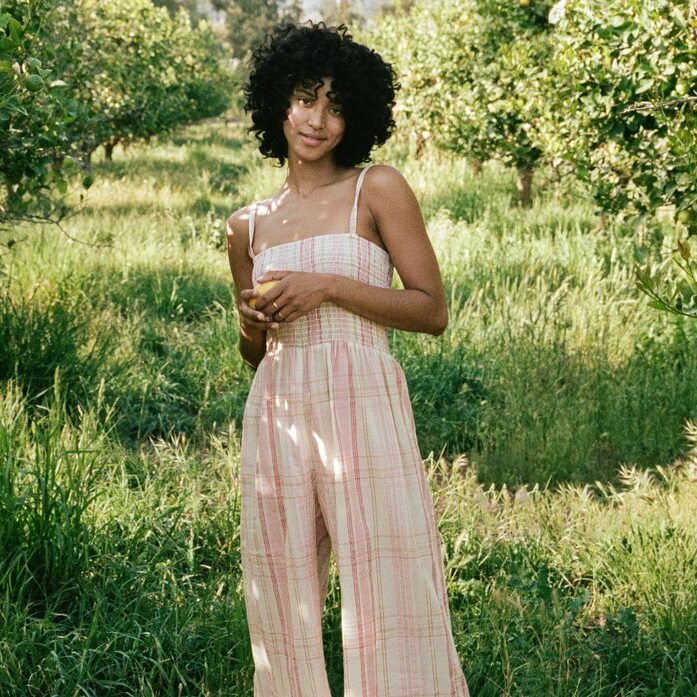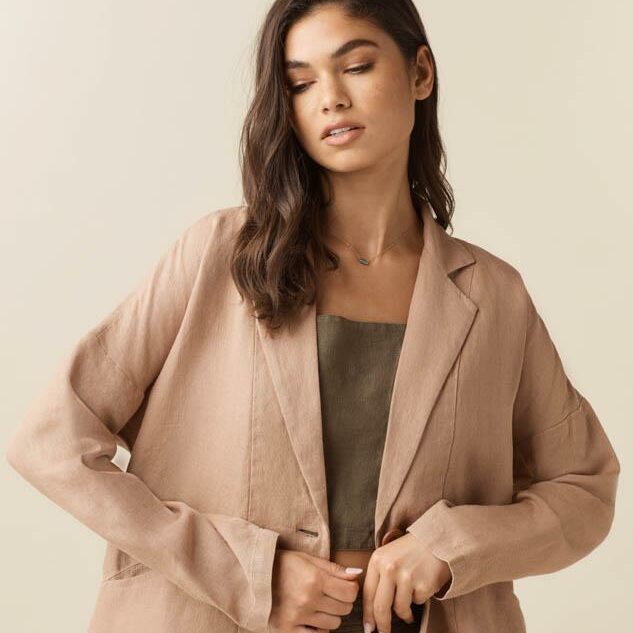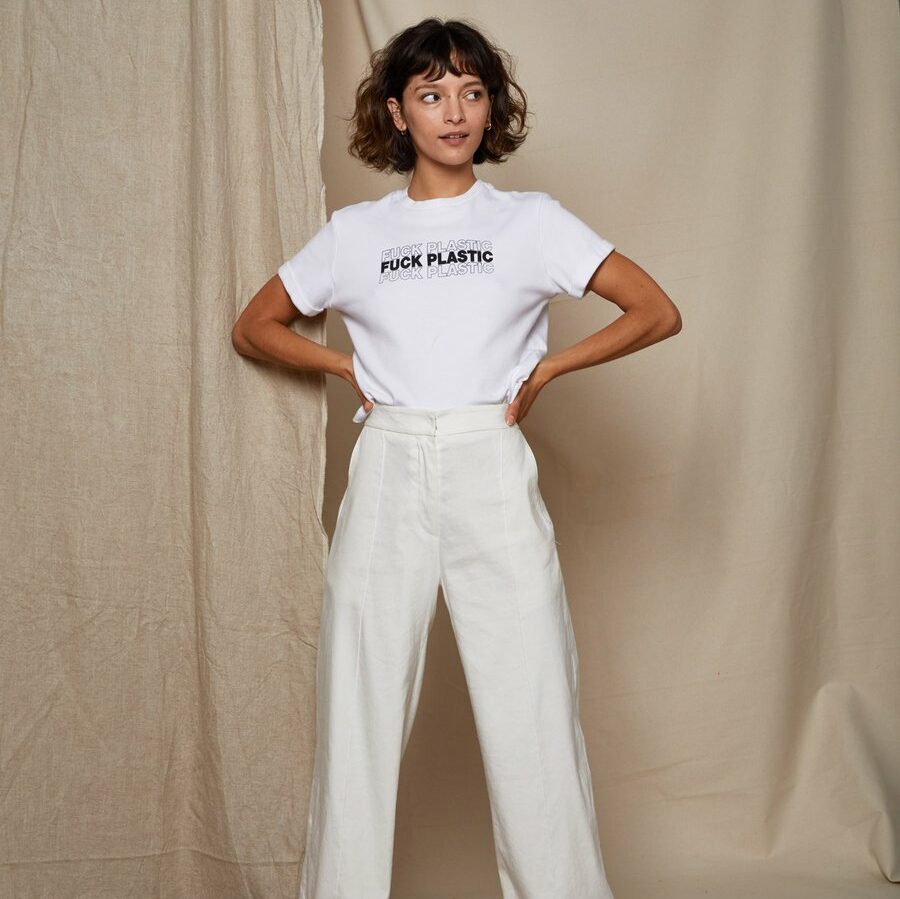As long as you haven’t been living under a rock, you’ve probably heard something about slow fashion.
The supposed antidote to everything wrong with the fashion industry, slow fashion has been getting a lot of attention lately. But what exactly is it and how do you shop for it? We’re here to answer all of your slow fashion questions so you can be sure you have a greener closet!
What Is Slow Fashion?
Essentially, slow fashion describes a departure from typical mass production methods which are designed to produce large amounts of consumer goods at the lowest cost possible.
The idea of slow fashion is to buy less and make your garments last.
Fast fashion brands focus on creating trendy, disposable clothes with frequent new arrivals – slow fashion aims to do the opposite.
History of Slow Fashion
The phrase “slow fashion” came to life in 2007, when journalist Kate Fletcher wrote an article about fast fashion. However, the “slow” concept has been around since the 1980’s.
Most notably, the Slow Food Movement was created in 1986 by Carlo Petrini in Italy, focusing on being more responsible about food. This concept aimed to use high-quality, clean ingredients with minimal waste while keeping the cost reasonable for consumers, while also promoting fair pay and working conditions.
This slow food movement caused a variety of other “slow” movements to arise, all of which were based on the same concepts.
How to Identify Slow Fashion
Slow fashion describes clothing which is:
- Designed to be durable and timeless rather than trendy and disposable
- Produced in small batches (often locally and sometimes even made-to-order)
- Made with natural, sustainable materials
Why Slow Fashion is Better
We know that mass production is sometimes a good thing. It makes things cheaper and more accessible, raising the standard of living and helping those in lower tax brackets afford clothing (and other items) they need for everyday life. So, why is fast fashion so bad?
In short, waste. In contrast to slow fashion, fast fashion is a high-volume business. Clothing is designed to be thrown away so customers keep shelling out money for the newest, trendiest items. For example, Fashion Nova releases over 500 new arrivals each week.
If you’ve bought a $10 pair of shoes to follow a trend, only to have them fall out of style (or fall apart) in a couple months, don’t be surprised. With fast fashion companies, that’s the intention.
According to the EPA, this has left its mark. Textile waste in the United States has practically doubled during the last 20 years.
Since the majority of fast fashion textiles are nonrenewable and non-biodegradable substances like polyester, that means they’re going to the landfill and staying there for centuries. As they break down, these waste products emit landfill gases like carbon dioxide and methane, which contribute to climate change.
Even more natural fabrics like cotton are expensive to produce ethically, leading most fast fashion companies to resort to open loop processes in which the chemicals aren’t recycled. This makes non-organic cotton one of the most environmentally intensive crops when it comes to habitat destruction, water waste, and pesticides.
On top of that, many fast fashion companies are able to charge crazy low prices because they are using unethical labor practices. This can include child labor, extremely long workdays, forced labor, and dangerous working conditions.
How Is Slow Fashion Different?
Rather than merely diverting textile waste that is inevitably created, slow fashion manufacturers and followers want to stop that waste from reaching the landfill in the first place.
To do that, slow fashion brands focus on creating pieces that are very durable and go with everything so you don’t have to throw all your old stuff away every time you pick up a new style.
When your pieces do finally wear out (this time in years rather than months), they’ll biodegrade quickly rather than sitting around producing methane because they’re made of natural materials.
How to Start a Slow Closet
Aside from shopping from slow fashion brands, what are some other ways to have more of a slow closet?
Thrift
The downside to many slow fashion brands is the fact that they are a lot more expensive than fast fashion. However, thrifting is a great way to shop more sustainably and create a slow closet without breaking the bank!
When thrifting, you’ll still want to look for garments that are from high-quality brands and will last you a long time.
However, you can be more lenient with the brands you buy when thrifting because you’re not directly supporting the brand! For example, if you find a fantastic quality coat from a fast fashion brand, you shouldn’t feel bad purchasing it because your dollar isn’t going right into their pocket.
You can visit a thrift store near you or shop from one of the many amazing online thrift stores!
Shop More Mindfully
Many of us are quick to purchase every item we think is cute and trendy, but to have a slower wardrobe, it’s important to be more thoughtful about your purchases. Would you actually wear that? Do you actually have outfits to pair it with?
It’s easier to shop less when you have a variety of garments that are easy to pair together, so we’d recommend being more mindful of the clothes you shop for.
Consider what your favorite garments in your closet are and shop around these. For example, if you always wear your favorite zebra-printed jeans, you might want to invest in high-quality basic shirts and jackets that will always match with these.
If you’re up for it, consider creating a capsule wardrobe!
Learn Upcycling Tricks
Many people get rid of clothes for small problems (like a small rip) that are shockingly easy to fix, or just because they’re sick of that particular garment.
However, there are so many easy tricks to turn an old garment into something brand new. To support the slow fashion movement, do a little research and learn some easy tricks to upcycle your clothes!
If you’re sick of your old jeans, look into how you can recycle them into a new piece (such as cutting them into shorts or distressing them for a new edgy look). If you’re done with that button up, turn it into a sexy off-the-shoulder top.
There are so many options out there to repurpose old clothes – get creative!
Research Every Brand
Sustainability is trendy at the moment, so many brands are using this to their advantage. Even if you find a seemingly great brand that advertises themselves as eco-friendly or sustainable, it’s still important to vet the company because they might not be all that great.
Look into their labor practices, materials they use, read reviews from other eco-friendly consumers, and analyze how many new items they release.
Top Slow Fashion Brands
It can be difficult to build a clean closet from scratch, so we’ve picked out a couple of brands to get you started.

Christy Dawn
If you want your natural cottagecore life to be more than an aesthetic, fulfill your vintage fantasies at Christy Dawn.
They have dreamy Edwardian inspired dresses made of deadstock fabric, organic cotton (so no pesticide runoff), and ethically raised wool.

Aura The Label
If you want sustainable fabrics, but don’t like all the flounces, Aura has bohemian pieces that are still sleek, minimalist and luxurious.
They’re made from sustainably-sourced linen and rayon, manufactured by workers in Bali who receive fair compensation.

Vetta
Vetta is your one-and-done solution to a sustainable wardrobe. You can purchase pieces separately, or you can buy an entire capsule which consists of five pieces that can mix and match to create 30 outfits.
They use organic cotton, tencel and deadstock to create amazing capsules that will fit perfectly into any wardrobe.

Arielle
There’s nothing like amazing workwear to make you feel like you can rule the world.
Arielle has all the classics you need for the office made of recycled wool and zero waste fiber derived from the leftover milk on German dairy farms.
Bottom Line
These brands will have everything you need to get started, but don’t forget that the most sustainable fashion is the fashion that’s already been loved!
There’s so much secondhand and vintage fashion out there waiting for a new home, and some of these companies even have buyback programs for their own pieces. It’s an awesome way to save the planet without breaking the bank.

